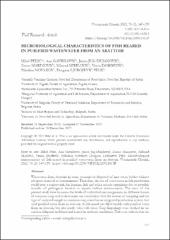| dc.description.abstract | Wastewater from abattoirs in some countries is disposed of into water bodies without adequate removal of contaminants. Therefore, the use of wastewater in fish production could pose a serious risk for humans, fish and other aquatic organisms due to possible transfer of pathogenic bacteria in aquatic culture environments. The aims of the present study were to assess the levels of individual microorganisms in different tissues of common carp and to determine any correlation with the season of sampling and the type of analysed sample in common carp reared in an integrated production system that used purified water from an abattoir. A fish pond was filled mostly with purified water from an abattoir, but also partly with well water. Carp fingerlings were stocked in the earthen fishpond in March and reared in ambient conditions. Fish were collected in the spring and autumn of the following year and the microbiological quality was assessed. Carp fillets with skin, gills and digestive tract samples were collected individually under aseptic conditions. All analyses were performed according to standard procedures. The levels of all the examined bacteria in the fish were under prescribed hygiene norms. Also, Listeria spp., sulphite-reducing clostridia and Staphylococcus aureus were not found in the samples. Furthermore, pathogenic bacteria, Salmonella and Listeria monocytogenes were not isolated from the samples. The hygienic quality of the fish produced in purified waste water from an abattoir was acceptable, and the common carp meat was safe for human consumption. Key Words: food safety, hygiene norms, integrated system, sustainability, wastewater, fish microbiology | en_US |

